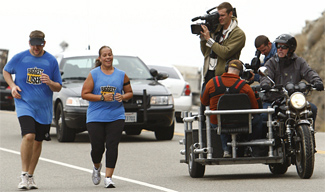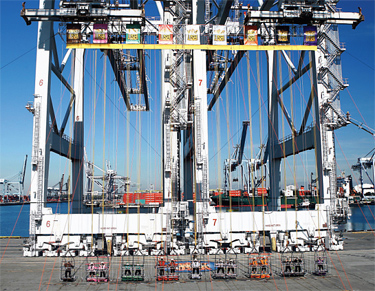Shooting to Win on 'The Biggest Loser'
LOS ANGELES
For the past seven seasons, NBC's "The Biggest Loser" has pitted weight-losing contestants against in each in contests of strength, endurance and willpower. (The show is produced by Reveille LLC, 25/7 Productions and 3 Ball Productions.) Now with season eight underway, series director Neil DeGroot and Director of Production Darrin Webb are working harder than ever to keep the show's visual fresh and appealing.
"There's only so many angles you can shoot an 'Elimination' segment from," DeGroot said. "We are always trying to refresh that. We are always trying to think of different ways to do it."
AVOIDING 'SAMENESS'

A camera crew follows contestants on the run during an episode of "The Biggest Loser." Eliminations are a standard set piece on "The Biggest Loser." So are the weekly weigh-ins, where contestants find out how much weight they have lost, and see how it affects the survival of their team (and in the final weeks, themselves). Add interview segments, and the danger of sameness reared its ugly head years ago.
"This is why we have altered the lighting and look of these sequences over the years," Webb said. "As well, this season we added a 180 degree circular dolly to the 'Elimination Set.' This allows us to do a flowing shot moving from one end of the shot to the other. It also imparts a cinematic quality to the video."
Where "The Biggest Loser"'s shooters really get challenged is outdoors, where many of the challenges are held. Depending on the week, contestants could be walking tightropes (with safety harnesses) above a gorge, running relays or swimming laps.
"We have 10-11 shooters covering the contestants on a given segment," said Webb. "All are using Sony IMX camcorders, which shoot in SD. We also have a variety of special camera rigs, such as our Stratocrane. At times we are using up to 10-11 of those rigs, depending on how big the shooting area is."
CHALLENGES
For Darrin Webb, the biggest challenge is making sure that his shooters are within constant range of the action. "This can be difficult if the event being covered is a 26.2 mile marathon, or a dash up a cliff," he said. "One of the most difficult shoots happened in season seven, where our contestants started in boats, then got into kayaks, then landed and hiked up 500 vertical feet up the side of Catalina Island, and then get into the kayaks again!"
To do this successfully, "we plan zone coverage," said DeGroot. "We literally divide the area up into zones and allocate shooters to each area. We keep in touch with them by phone and two-way radio. If something happens, we can dispatch them quickly to where something is happening, or skip ahead on the course so that the cameras are in place waiting for the contestants to arrive."
Figuring out zone coverage is not easy, DeGroot admitted. "Even after scouting the site the day before the shoot, it seems like it just won't work," he said. "It's often not until I wake up at 3 a.m. on Challenge Day that a plan comes into my mind, showing me a method that meets up with our madness." But even then, it is vital for the show's ca-merapeople to be ready to scramble at a moment's notice. The worst thing is not to have someone where the excitement is happening!"

A Strata crane was used in Season 7 as part of The Biggest Loser "Challenge." Photo copyright Trae C. Patton To manage wide-ranging shoots, DeGroot takes to the air. "I like to use a helicopter to direct coverage, so that I can ensure that everyone is in the right place at the right time," he said. "The shooters just can't see the 'big picture' on the ground, despite the fact that they are experienced and have been with the show for years. You need a high angle view to see what's happening."
Toshiba miniature 'Ice Cube' cameras and BulletCams are used for on-body shooting, with the video going by wire to a belt-worn recorder using MiniDV tape or SD cards. The Ice Cubes can be attached to clothing, while the BulletCams are perfect for sticking onto helmets. "We also use the Ice Cubes for unique shots, such as the time the contestants had to rustle through a bowl of keys," said Webb. "To give a key's eye view of the action, we installed an Ice Cube in the bowl itself, with the keys. This allowed the viewer to see the action from a different and new angle."
LOOKING AHEAD
It isn't easy keeping a long-running show visually compelling for regular viewers; especially when it relies on set pieces and a consistent overarching theme. But DeGroot and Webb are obsessed with doing so. One way DeGroot hopes to revitalize "The Biggest Loser"'s look "is to go HD next season," he said. Another is to keep changing the settings in which the show is shot, to mix things up and keep them lively. "We see the environment in which we shoot as a regular character in the program," Webb said. "We use it, and the ways in which we shoot, to aid the storytelling—and to deliver truths about the contestants and the events unfolding on screen."
"We are always trying to do things differently on 'The Biggest Loser,'" DeGroot concluded. "We never want the show to look flat or stale. That's why we work so hard to get unique shoots!"
The professional video industry's #1 source for news, trends and product and tech information. Sign up below.
James Careless is an award-winning journalist who has written for TV Technology since the 1990s. He has covered HDTV from the days of the six competing HDTV formats that led to the 1993 Grand Alliance, and onwards through ATSC 3.0 and OTT. He also writes for Radio World, along with other publications in aerospace, defense, public safety, streaming media, plus the amusement park industry for something different.

